Check this out: iHerb Best Sellers
The most popular products, based on sales within the past 24 hours
Imagine this iconic scene from the movie “Ratatouille“: Remy the rat, with his keen sense of smell and taste, creates a dish that not only saves the day but also wows the toughest food critic in Paris. The dish, ratatouille, is a medley of fresh vegetables cooked with care and attention, highlighting the film’s underlying message – great food is a labor of love that starts with excellent ingredients.


Much like Remy, we can transform our kitchens into hubs of health and wellness, where every dish not only tantalizes our taste buds but also nourishes our bodies. The path to healthy eating doesn’t need to be complex or tedious. With some simple strategies and a bit of know-how, we can turn the foods we love into meals that love us back. In this article, we will explore thirteen healthy cooking tips that will help you create delicious and nutritious dishes, worthy of a five-star rat-chef approval!
1. Use Simple, Raw Ingredients

Cooking with fundamental, unprocessed ingredients such as raw fruits, vegetables, lean proteins, and whole grains is a step towards eating healthier. It involves preparing meals from scratch, ensuring you are consuming food in its most natural form, devoid of additives.
This approach is backed by science. According to a study published in the Journal of the American Medical Association, individuals who follow a diet of unprocessed foods have a lower risk of developing cardiovascular diseases and diabetes. As the famous food writer Michael Pollan once stated, ‘Don’t eat anything your great-grandmother wouldn’t recognize as food.’ This advice underlines the importance of choosing natural, recognizable ingredients in our meals.
2. Avoid Cooking at High Temperatures and Deep Frying
Steering clear of high-heat cooking methods and deep frying is an effective way to preserve the nutritional quality of your food and mitigate health risks. For example, when grilling or pan-frying, it is recommended to keep the temperature below 148°C (300°F) to prevent the formation of harmful compounds like heterocyclic amines (HCAs) and polycyclic aromatic hydrocarbons (PAHs). Similarly, baking should be done at moderate temperatures, ideally between 160-180°C (325-350°F) to ensure proper cooking without unnecessary nutrient loss. Additionally, when sautéing vegetables, a lower heat setting (around 120°C or 250°F) is suggested to maintain their nutritional profile while preventing overheating.
The renowned Chef Julia Child once said, “You don’t have to cook fancy or complicated masterpieces — just good food from fresh ingredients,” a philosophy that can certainly be applied to our cooking methods. By keeping cooking temperatures moderate and avoiding deep frying, we’re better able to retain the goodness of our ingredients, thus creating healthier and more wholesome meals.
3. Use More Fruits, Vegetables, and Greens
Integrating more fruits, vegetables, and leafy greens into your diet is a key element of healthy eating. These foods are rich in essential vitamins, minerals, fiber, and antioxidants, which are crucial for overall health and disease prevention. The USDA recommends making half of your plate fruits and vegetables at each meal, illustrating their significance in a balanced diet. For an average adult, it’s advisable to consume at least 2 cups of fruit and 2.5 cups of vegetables per day. Try to include a variety of colors to ensure you’re getting a wide range of nutrients – for instance, vibrant leafy greens like spinach and kale are excellent sources of vitamins A, C, K, and calcium, while fruits like oranges, berries, and apples are packed with vitamin C and fiber.

Dr. Joel Fuhrman said, “The more colorful the food, the better. I try to add color to my diet, which means vegetables and fruits.” By including more fruits, vegetables, and greens in your meals, you’ll be boosting both the nutritional value and the visual appeal of your dishes.
4. Choose Healthy Oils for Cooking

It’s essential to discern between healthier and less healthy cooking oils. Oils high in trans and saturated fats, like palm oil and partially hydrogenated oils, are detrimental to heart health. On the other hand, oils rich in monounsaturated and polyunsaturated fats, like olive oil, avocado oil, and canola oil, can promote heart health by improving cholesterol levels. For instance, extra-virgin olive oil, high in monounsaturated fats and antioxidants, is ideal for salad dressings and sautéing at medium temperatures, as its smoke point is around 190-215°C (375-420°F). Avocado oil, with its high smoke point of 270°C (520°F), is a versatile choice suitable for many cooking methods, including grilling, baking, and sautéing. Canola oil, another good option, can be used for various cooking techniques, including roasting and stir-frying, as it has a moderately high smoke point around 200-230°C (390-450°F).
Remember that even healthy oils should be used in moderation due to their high caloric content. By paying attention to the types and quality of oils you use, you can improve the nutritional profile of your dishes while enhancing their flavor.
5. Focus on Healthy Fats and Lean Proteins
Adopting a diet that emphasizes healthy fats and lean proteins can support overall health, from enhancing heart health to promoting weight management. Healthy fats, such as those found in avocados, nuts, seeds, and fatty fish like salmon, provide essential fatty acids and support vitamin absorption. They’re also crucial for brain function and reducing inflammation in the body. When selecting oils for cooking, opt for those high in monounsaturated and polyunsaturated fats, such as olive, avocado, and canola oil.
Lean proteins, on the other hand, are low in saturated fat and high in essential amino acids. They contribute to a feeling of fullness, support muscle growth and repair, and aid in numerous physiological functions. Options include skinless poultry, fish, eggs, legumes, and low-fat dairy products. When it comes to red meat, choose lean cuts and limit your intake due to their higher saturated fat content.
Balancing your diet with these healthy fats and lean proteins can contribute to better heart health and support a healthy weight. As acclaimed nutritionist Joy Bauer noted, “Choosing the right type of fats and a good balance of proteins in your diet can give your body the fuel it needs while also supporting your health goals.”
6. Use Seasoned Products
Incorporating seasoned products into your culinary repertoire can greatly enhance the flavor of your dishes without adding unnecessary calories or unhealthy ingredients. Using spices, herbs, and other natural flavor enhancers not only contributes to a vibrant and diverse palette of tastes but also offers various health benefits. For instance, turmeric is known for its anti-inflammatory properties, while garlic can help lower cholesterol and blood pressure. Seasoned vinegars or oils, such as balsamic vinegar or rosemary-infused olive oil, can add a depth of flavor to salads, marinades, or cooked vegetables.
Using vegetable broths or stocks seasoned with herbs and spices can add a hearty flavor to soups, stews, or grains without relying on high-sodium bouillon cubes. As you experiment with different seasonings, you’ll discover new flavor profiles and elevate your home-cooked meals.
As the renowned chef Wolfgang Puck once said, “Cooking is like painting or writing a song. Just as there are so many notes or colors, there are only so many flavors – it’s how you combine them that sets you apart.” Seasoned products can provide a palette of flavors for you to create your culinary masterpiece.
7. Limit Added Sugar and Salt
Monitoring your intake of added sugar and salt is crucial for maintaining good health. Consuming too much added sugar can lead to weight gain, heart disease, and increased risk of type 2 diabetes. Similarly, excessive salt intake can raise blood pressure and contribute to heart disease and stroke. Try to limit processed foods, which are often high in both added sugars and salt. Opt for natural sweeteners like fruits and honey to curb your sweet cravings. You can also use spices, herbs, and citrus juice to enhance the flavor of your food instead of salt.

The American Heart Association recommends limiting added sugars to 6 teaspoons (or 24 grams) per day for women and 9 teaspoons (or 36 grams) for men. While these might seem like high amounts, they’re actually significantly less than the average sugar intake in the United States. According to the U.S. Department of Health and Human Services, the average American consumes around 17 teaspoons (or about 71.14 grams) of added sugar each day.
It’s important to note that these recommendations refer to “added sugars,” which are added to foods and beverages during processing or preparation, not naturally occurring sugars found in fruits, vegetables, and dairy products.
However, many health organizations, including the World Health Organization (WHO), recommend even lower intakes. The WHO suggests that less than 10% of total daily energy intake should come from free sugars, which equates to about 50 grams or 12 teaspoons per day for a normal weight adult. For additional health benefits, they suggest reducing this to below 5% of total energy intake, or roughly 25 grams (6 teaspoons).
Therefore, while the AHA’s recommendations are lower than the average intake, they are on the higher end compared to some other health organization’s guidelines. It’s always important to consider individual health needs and consult with a healthcare professional for personalized dietary advice.
Small shifts in dietary patterns – like cutting back on added sugars and salt – can have a significant impact on health over time.
8. Steam or Stir-Fry
Steaming and stir-frying are excellent choices that retain the nutritional integrity of your ingredients while enhancing their flavors. Steaming is a gentle cooking method that doesn’t require oil, preserving the vitamin and mineral content of your vegetables, fish, or poultry. You can steam a variety of foods, from broccoli and carrots to fish fillets and chicken breasts.

Stir-frying, on the other hand, is a quick, high-heat cooking method that seals in the flavors and nutrients of your ingredients. Use a small amount of a healthy oil like avocado or canola oil and toss in your choice of lean proteins and colorful vegetables. Add some herbs, spices, or a low-sodium sauce for a flavorful finish.
9. Eat Enough Fibre
Incorporating adequate fibre into your diet is essential for a healthy digestive system and overall well-being. Fibre can help regulate your body’s use of sugars, keeping your hunger and blood sugar in check. It also aids in achieving a healthy weight, lowering cholesterol levels, and reducing the risk of chronic diseases.
Rich sources of fibre include whole grains like brown rice, oats, and whole wheat bread or pasta. Fruits and vegetables, particularly when eaten with their skins, also provide a substantial amount of fibre. These include berries, apples, oranges, pears, peas, Brussels sprouts, and potatoes. Legumes, such as beans, lentils, and chickpeas, are also excellent fibre sources.
The American Dietetic Association recommends a daily intake of 25 grams of fibre for women and 38 grams for men. Consuming a variety of fibre-rich foods not only benefits your digestive health but contributes to your overall health and wellness.
10. Flavor with Natural Herbs and Spices
Using natural herbs and spices is a wonderful way to add flavor to your meals without adding excess sodium or fat. They also offer various health benefits, thanks to their high antioxidant content. For instance, turmeric is known for its anti-inflammatory properties, while ginger aids in digestion.
Certain herbs and spices pair particularly well. Rosemary, with its earthy and pine-like flavor, complements red meats like lamb and beef perfectly. Thyme and sage are also excellent for enhancing the taste of poultry. Seafood pairs wonderfully with dill, parsley, and lemon zest, bringing out the fresh flavors of fish and shellfish.
For vegetarian dishes, cumin, coriander, and paprika can add depth and complexity to beans, lentils, and tofu. Oregano, basil, and garlic work well in pasta dishes and tomato sauces, bringing a taste of the Mediterranean to your kitchen.

Experimenting with different herbs and spices can help you create restaurant-quality, healthful meals right at home.
11. Use Fermented Products
Adding fermented products is a fantastic way to boost your gut health and add a tangy depth of flavor to your dishes. These foods are rich in probiotics, which are beneficial bacteria that support digestion, immunity, and potentially even mood regulation.
Yogurt is one of the most common fermented foods and is a versatile ingredient that can be used in both savory dishes and sweet desserts. Look for plain, unsweetened varieties to avoid added sugars, and opt for those that specify “live and active cultures” on the label for the maximum probiotic benefits.

Kefir, a fermented milk drink, can be enjoyed on its own or added to smoothies for a probiotic boost. Sauerkraut and kimchi, fermented cabbage products from Germany and Korea respectively, are fantastic in sandwiches or as a side dish. They offer a tangy flavor and crunchy texture that can elevate any meal.
Ayran is a Turkish yogurt-based drink made by diluting yogurt with water and adding salt, while kefir is a fermented milk drink originating from the Caucasus region. Ayran has a tangy and slightly salty flavor, while kefir has a tangy and slightly sour taste.
While it’s not necessarily an indicator, my stepfather used to drink a glass of kefir every evening, and he is now 89 years old. About 15 years ago, we had an incident at the airport where they didn’t want to check him in for his flight because he looked much younger than the age stated in his passport. It took some effort to convince the clerk that it was indeed his passport.
Kvass is a fermented beverage popular in Eastern European countries like Russia, Ukraine, and Belarus. Made from fermented rye bread or other grains, it undergoes a process of fermentation where yeast converts sugars into alcohol and carbon dioxide. The result is a mildly alcoholic and naturally carbonated drink with a tangy and refreshing flavor. Kvass is enjoyed cold, especially during summer, and is known for its probiotic content, providing potential health benefits for the gut, as well as being a good source of B vitamins and minerals. Its unique taste and cultural significance have made kvass a beloved traditional beverage in the region.
Other excellent fermented foods include tempeh, a fermented soy product that’s a great source of plant-based protein, and miso, a Japanese paste that can be used in soups and sauces.
Fermented products have been associated with potential benefits for longevity due to their positive impact on gut health and overall well-being. Fermentation introduces beneficial bacteria and probiotics into the digestive system, promoting a healthy gut microbiome. A balanced and diverse gut microbiota has been linked to improved immune function, reduced inflammation, and better nutrient absorption.
12. Avoid Margarine or Cream-Based Sauces
While margarine and cream-based sauces can certainly add rich flavors to your dishes, they often contain high levels of unhealthy fats and calories. Margarine, in particular, may contain trans fats, which are associated with increased heart disease risk. Instead, consider healthier alternatives to keep your meals tasty and nutritious.
For a creamy texture without the heavy fat content, use Greek yogurt, pureed beans, or avocados. Greek yogurt works well in both sweet and savory dishes, providing a tangy, creamy element. Pureed beans add heartiness and creaminess to soups and dips. Avocados can make a deliciously creamy pasta sauce or an alternative to mayonnaise in sandwiches.
For butter substitutes in cooking and baking, consider using olive oil or coconut oil. Both are high in healthier fats and add a unique flavor to your dishes.
In place of cream-based sauces, opt for sauces made with tomatoes, broth, wine, or vinegar, which can add depth and flavor without the extra fat and calories. For example, a tomato-based marinara sauce is a healthier choice over a cream-based alfredo sauce for pasta dishes.
Remember, as Julia Child famously said, “You don’t have to cook fancy or complicated masterpieces – just good food from fresh ingredients.” With these alternatives, you can enjoy the rich, creamy textures and flavors you love in a healthier way.
13. Minimize Processed Foods
Reducing your intake of processed foods is a vital step towards a healthier lifestyle. Processed foods typically contain high levels of added sugars, sodium, unhealthy fats, and chemical additives, while being low in fiber and essential nutrients.
Common examples of processed foods include fast food, sugary drinks, candy, baked goods, and instant noodles. Many convenience foods, such as frozen dinners, canned soups, and snack foods like chips and crackers, also fall into this category. Even some seemingly healthy options, like breakfast cereals, granola bars, and flavored yogurts, can be heavily processed and packed with added sugars.
Incorporating these tips into your everyday cooking practices can significantly improve your health and wellbeing. They encourage a holistic approach to diet that emphasizes whole foods, careful preparation methods, and a wide variety of ingredients to meet your nutritional needs. Remember that the key to a healthy diet is balance and variety.
The importance of a balanced and mindful diet has been recognized for millennia. In ancient literature, Hippocrates, the father of medicine, once said: “Let food be thy medicine, and let medicine be thy food.” This timeless wisdom underscores that the foods we choose to consume have a profound impact on our health and longevity. It’s not about temporary diets or quick fixes; it’s about creating sustainable, long-term changes that nourish your body, satisfy your palate, and enhance your life. Here’s to healthier cooking and a healthier you!
Disclaimer
The information provided in this article is for general informational purposes only. The content presented on this website should be considered solely as opinions and personal experiences. Read more

Ease your mind about the ingredients in your meals. When you’re the chef, you have full visibility and control over the amount of oil, sugar, and other components you add. This transparency allows you to be responsible for what goes into your food. However, it’s important to be aware of the nutritional content of the dishes you prepare. If a recipe doesn’t align with your dietary preferences or health goals, feel free to remove it from your collection and substitute it with something that better suits your needs.